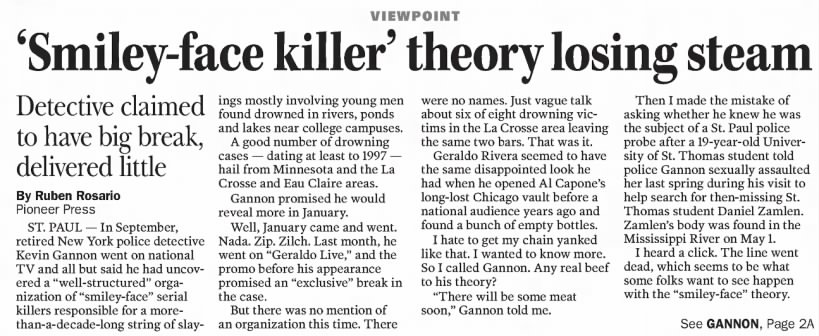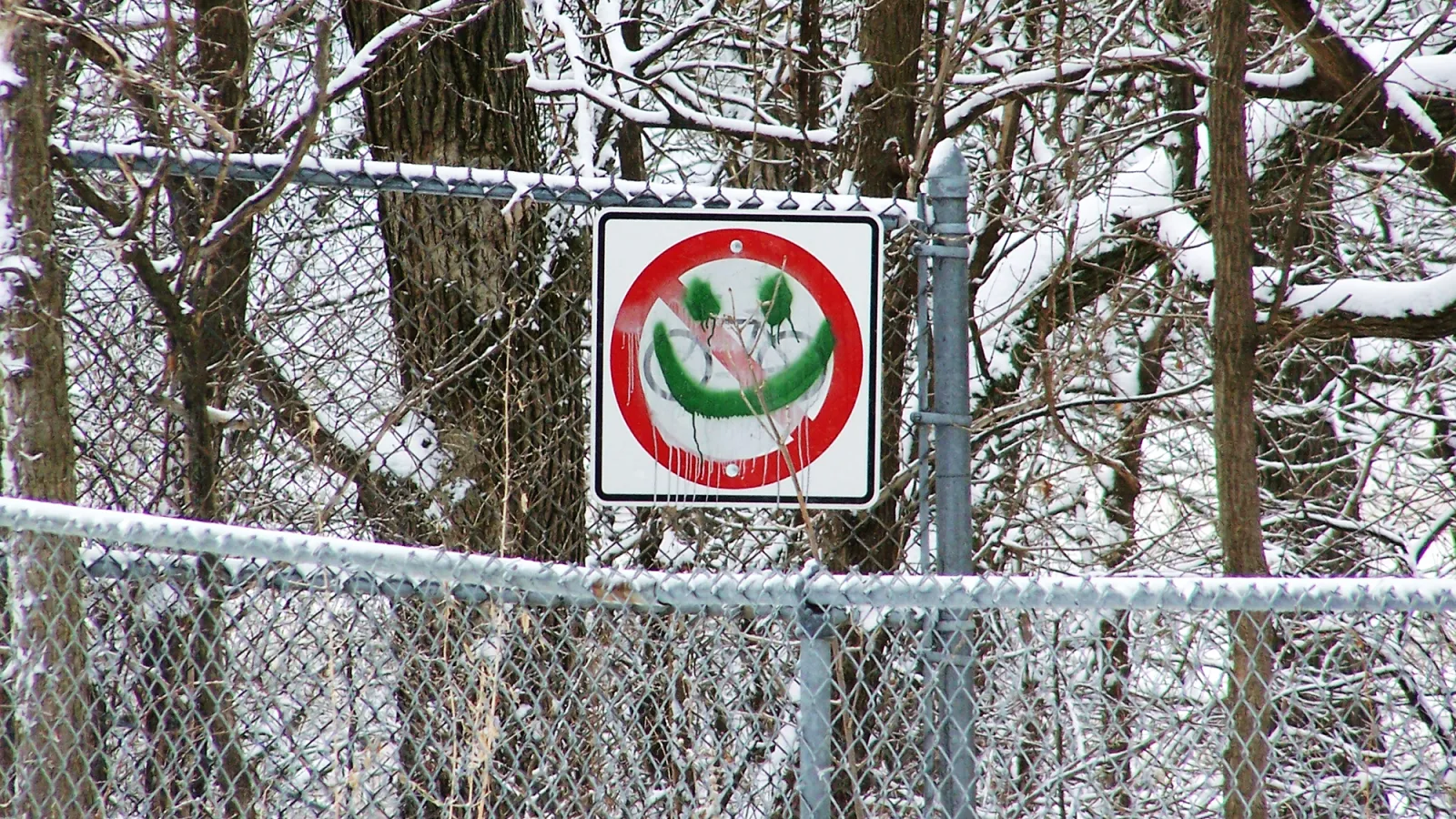
Prepare to be captivated by a spine-tingling journey into the dark and enigmatic world of the Smiley Face Killers. This chilling phenomenon has baffled investigators and sent shockwaves through true crimeenthusiasts worldwide. Imagine a series of unsolved cases, each involving young, seemingly unconnected men who mysteriously vanish, only to turn up deceased in bodies of water. The sinister twist? In many of these cases, a graffiti smiley face symbol is found nearby.
As we explore these perplexing cases, you'll be drawn into a web of conspiracy theories, police investigations, and the relentless pursuit of justice. The Smiley Face Killers saga is not just a true crime story; it's a pulse-pounding rollercoaster that blurs the lines between reality and urban legend. With each revelation, you'll question everything you thought you knew, and the unnerving truth behind these baffling incidents will keep you on the edge of your seat.
The Mysterious Death Of Dakota James
The smiley face murder theory (also known as the smiley face murders, smiley face killings, and smiley face gang) is a theory that a serial killer or killers have been targeting and drowning young men across the United States. The theory is based on the fact that many of the victims have been found with smiley faces carved into their bodies or near the crime scene.
The theory was first proposed in 2003 by Keith Cheshire, a retired New York City police detective. Cheshire noticed that many of the unsolved drowning deaths of 45 years young men in the United States had similarities, including the fact that the victims were often found in bodies of water near bridges or other structures, and that they often had smiley faces carved into their bodies.
Cheshire believes that the smiley faces are a signature of the serial killer or killers, and that they are meant to send a message to the police. He also believes that the killer or killers are likely to be young men themselves, and that they may be targeting their victims because they feel a sense of kinship with them.
The smiley face murder theory has been met with skepticism by some law enforcement officials, but it has also gained support from others. In 2009, the FBI released a report that stated that the smiley face murder theory was "not credible." However, the report also acknowledged that there were some similarities between the unsolved drowning deaths of young men across the United States.
The theory has also been the subject of several books and documentaries, and it has been featured in several episodes of popular television shows.
Dakota James was a 22-year-old man who was found drowned in the Mississippi River in 2009. His body was found near the I-35W Bridge in Minneapolis, Minnesota. The smiley face murder theory was brought up in the investigation of James's death, but the police ultimately concluded that his death was an accident.
James's family and friends have expressed skepticism about the official conclusion of the investigation. They believe that James was murdered, and that the smiley face murder theory is a possible explanation for his death.
The smiley face murder theory remains a controversial topic. There is no definitive proof that the theory is true, but there is also no definitive proof that it is false. The theory continues to be investigated by some law enforcement officials and amateur sleuths.
The “Smiley Face Killers”
The "Smiley Face Killers" is a term used to describe a hypothetical serial killer or killers who are believed to be targeting young men across the United States. The theory is based on the fact that many of the victims have been found drowned in bodies of water near bridges or other structures, and that smiley faces have often been carved into their bodies or found near the crime scene.
The theory was first proposed in 2003 by retired New York City police detective Keith Cheshire. Cheshire noticed that many of the unsolved drowning deaths of young men across the United States had similarities, and he believed that they could be the work of a serial killer or killers. He also noted that many of the victims had been found with smiley faces carved into their bodies, which he believed could be a signature of the killer or killers.
Cheshire's theory has been met with skepticism by some law enforcement officials, but it has also gained support from others. In 2009, the FBI released a report that stated that the "Smiley Face Killers" theory was "not credible." However, the report also acknowledged that there were some similarities between the unsolved drowning deaths of young men across the United States.
Despite the FBI's skepticism, the "Smiley Face Killers" theory has remained popular in the media and among amateur sleuths. There have been several books and documentaries made about the theory, and it has been featured in several episodes of popular television shows.
One of the most well-known cases associated with the "Smiley Face Killers" theory is the case of Brian Shaffer. Shaffer was a 27-year-old medical student who disappeared from a bar in Columbus, Ohio in 2002. His body was never found, but smiley faces were found carved into trees near the bar where he disappeared.
Another well-known case is the case of Brandon Swanson. Swanson was a 19-year-old college student who disappeared after a party in Marshall, Minnesota in 2008. His body was found in the Redwood River a few days later. Smiley faces were found carved into trees near the river where his body was found.
The "Smiley Face Killers" theory is a complex one, and there is no definitive proof that it is true. However, there is also no definitive proof that it is false. The theory continues to be investigated by some law enforcement officials and amateur sleuths.
Debunking The Theory
There are a number of factors that have led to the debunking of the "Smiley Face Killers" theory.
- There is no physical evidence linking the cases together -The smiley faces that have been found near some of the crime scenes are often crudely drawn and inconsistent in appearance. Some experts believe that the smiley faces are simply graffiti that has been misinterpreted by the supporters of the theory.
- The victims' deaths are consistent with accidental drowning -Many of the victims had been drinking alcohol before their deaths, and they were found in bodies of water that were known for being dangerous swimming areas.
- There is no motive for the killings -The supporters of the theory have not been able to provide a convincing motive for the killings. Why would a serial killer target young men and drown them in bodies of water? There is no clear answer to this question.
- The FBI has investigated the theory and found no evidence to support it -In 2009, the FBI released a report that stated that the "Smiley Face Killers" theory was "not credible." The FBI's report concluded that there was no evidence that the cases were linked, and that the deaths were most likely accidental drownings.
Despite the evidence that has been presented against it, the "Smiley Face Killers" theory continues to have some supporters. However, the majority of law enforcement officials and experts believe that the theory is not credible.
Here are some specific examples of the evidence that has been used to debunk the "Smiley Face Killers" theory:
- In the case of Brian Shaffer, the smiley faces that were found near the bar where he disappeared were not actually carved into trees. They were simply graffiti that had been drawn on the sidewalk.
- In the case of Brandon Swanson, the smiley faces that were found near the river where his body was found were also not actually carved into trees. They were simply painted on the rocks near the riverbank.
- A study by the Center for Homicide Research found that there is no statistical correlation between the number of smiley faces that are found near bodies of water and the number of young men who drown in those bodies of water.
- The FBI's investigation of the "Smiley Face Killers" theory found no evidence of a serial killer or killers operating in the United States.
Has The Smiley Face Killer Been Caught?
No - the hypothetical serial killer or killers known as the "Smiley Face Killers" have not been caught. The theory is based on the fact that many of the victims have been found drowned in bodies of water near bridges or other structures, and that smiley faces have often been carved into their bodies or found near the crime scene.
The theory was first proposed in 2003 by retired New York City police detective Keith Cheshire, who noticed that many of the unsolved drowning deaths of young men across the United States had similarities. He believed that the victims were being targeted by a serial killer or killers, and that the smiley faces were a signature of the killer or killers.
The "Smiley Face Killers" theory has been met with skepticism by some law enforcement officials, but it has also gained support from others. In 2009, the FBI released a report that stated that the theory was "not credible." However, the report also acknowledged that there were some similarities between the unsolved drowning deaths of young men across the United States.
Despite the FBI's skepticism, the "Smiley Face Killers" theory has remained popular in the media and among amateur sleuths. There have been several books and documentaries made about the theory, and it has been featured in several episodes of popular television shows.
Some of the most well-known cases associated with the "Smiley Face Killers" theory include:
- Brian Shaffer -Shaffer was a 27-year-old medical student who disappeared from a bar in Columbus, Ohio in 2002. His body was never found, but smiley faces were found carved into trees near the bar where he disappeared.
- Brandon Swanson -Swanson was a 19-year-old college student who disappeared after a party in Marshall, Minnesota in 2008. His body was found in the Redwood River a few days later. Smiley faces were found carved into trees near the river where his body was found.
- Dakota James -James was a 22-year-old man who was found drowned in the Mississippi River in 2009. His body was found near the I-35W Bridge in Minneapolis, Minnesota. The smiley face murder theory was brought up in the investigation of James's death, but the police ultimately concluded that his death was an accident.
How Many People Has The Smiley Face Killer Killed?
The exact number of people killed by the Smiley Face Killer is unknown. Some people believe that the Smiley Face Killer is a serial killer who has killed hundreds of people, while others believe that the theory is a hoax.
The Smiley Face Killer theory is based on the fact that many of the victims have been found drowned in bodies of water near bridges or other structures, and that smiley faces have often been carved into their bodies or found near the crime scene.
The theory was first proposed in 2003 by retired New York City police detective Keith Cheshire. Cheshire noticed that many of the unsolved drowning deaths of young men across the United States had similarities, and he believed that they could be the work of a serial killer or killers. He also noted that many of the victims had been found with smiley faces carved into their bodies, which he believed could be a signature of the killer or killers.
Cheshire's theory has been met with skepticism by some law enforcement officials, but it has also gained support from others. In 2009, the FBI released a report that stated that the Smiley Face Killer theory was "not credible." However, the report also acknowledged that there were some similarities between the unsolved drowning deaths of young men across the United States.
Despite the FBI's skepticism, the Smiley Face Killer theory has remained popular in the media and among amateur sleuths. There have been several books and documentaries made about the theory, and it has been featured in several episodes of popular television shows.
See Also:Is Ben Franklin A Serial Killer?
Frequently Asked Questions About Smiley Face Killer
What Did The Smiley Face Killer Do?
Robert Lee Yates (born 1952), serial killer who used plastic bags with a smiley face printed on them to cover the heads of his victims. Smiley face murder theory, a theory about smiley faces near the bodies of young men killed by drowning between 1992 and 2018.
What Is The Movie Smiley Face Killers Based On?
the Smiley face murder theoryDid you know. Loosely based on the Smiley face murder theory in which the bodies of young men have been mysteriously found in water with smiley face graffiti nearby, dating back to the 1990s.
Was The Smiley Face Killer Real?
Reception of the theoryThe La Crosse, Wisconsin police department, which was in charge of eight of the investigations, concluded that the deaths were accidental drownings of inebriated men and stated that no smiley-face symbols were found in connection with any of the cases.
Conclusion
the Smiley Face Killers remain a disturbing and perplexing enigma in the realm of true crime. Despite the controversial debates and unresolved questions that shroud this series of cases, one thing is certain: the victims and their families deserve answers. The collective efforts of law enforcement, amateur sleuths, and concerned citizens continue to push for resolution and justice, underscoring the unwavering human drive to seek the truth, even in the face of a mystery as dark and convoluted as this one.
As we close the chapter on this unsettling tale, the Smiley Face Killers will persist as a haunting reminder of the complexities that can emerge in our pursuit of justice. The story serves as a testament to the enduring power of curiosity and determination, driving us to uncover the truth behind the most bewildering of mysteries. Whether you believe it to be the work of a shadowy serial killer or a string of chilling coincidences, the legacy of the Smiley Face Killers reminds us that even in the most ominous of circumstances, the quest for answers and justice endures.


